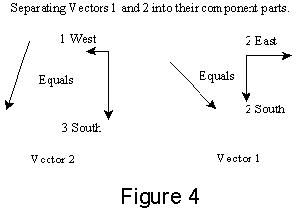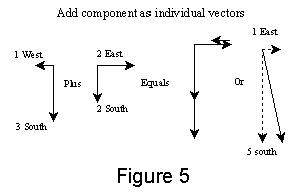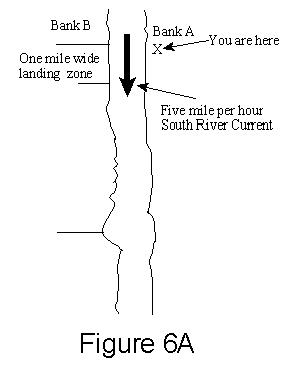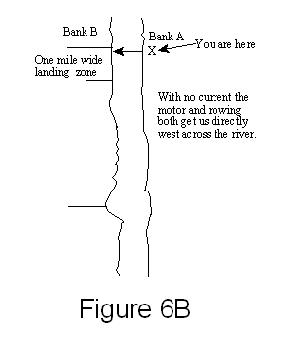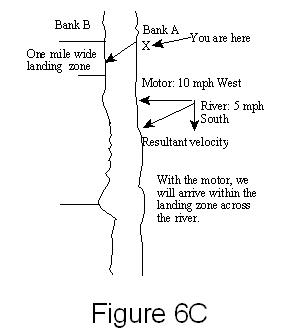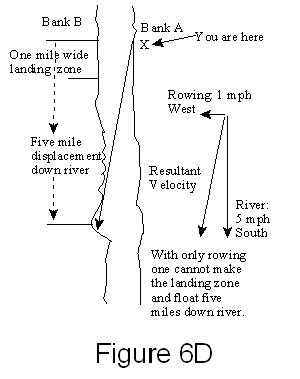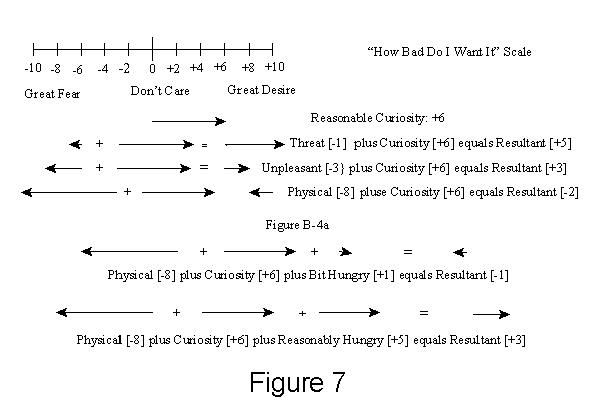|
|
Vectors and creativity
|
|
A Releasing Your Unlimited Creativity discussion topic | |
|
Copyright 2008 by K. Ferlic, † All Rights Reserved | |
| RYUC Home Why free? Contact Links Programs Services Contributions | |
|
Vectors and creativity Vectors are a mathematical/physics quantity which has a magnitude and a direction. What is important about vectors is because vectors have a direction, they add and subtract slightly differently than adding and subtracting numbers. Relative to our creativity, whether we realize it or not, creation/Creation is directional. Whether or not our consciousness is aware of the direction it is intending by how it has focused its attention and awareness is another issue. In the world of physics there is a concept call the vector. In the world of the things that physics studies, there are quantities that can be effectively characterized by a single number. Some things such as age, height, weight, time can be described by a single number. Five years old, six feet high, 20 minutes "turn around time" and the like are all adequate for what they are describing by the use of only a number. In the same way, a speed 60 miles per hour or 30 miles per hour adequately describes how fast one is going or to say New York City is 229 mile from Washington DC, is adequate to say how far New Your is from Washington. It is because the quantity being discussed - how old, how high, how fast, how far, only have a size or magnitude. However there are other quantities that have both a magnitude or size, and a direction. In these cases the single number is insufficient to completely describe the quantity being discussed. For example, 60 miles per hour going north is different that 60 miles per hour going east. Similarly going 229 miles South from Washington DC is not going to get us to New York but closer to Raleigh NC (264 miles). In these cases the direction become significant and the direction is needed to adequately describe the quantity. These quantities have both a size or magnitude and a direction are call vectors. What is intriguing about vector quantities is that they can be effectively represented by drawing. Vectors can be represented by arrows where the length of the arrow, drawn to a convenient scale, represents the magnitude if the quantity and the direction of the arrow is representative of the direction of the quantity. By drawing these arrows and using them symbolically vector going in different directions of differing magnitudes can easily be added and subtracted giving a total resultant vector that is the composite of the original vector and representative of the final direction and motion. Let us look at an example. Figure 1 represents a typical situation. In Figure 1 there are two vectors. One vector is of magnitude 2 mile per hour West and a second 3 miles per hour South. The direction West and South are completely independent of each other. We could go forever South and never reach West and the same is true for going West. Going West will never take us South. If both of these vectors act simultaneously on the same object as
in Figure 2, the actual direction of travel will be both South and
West. Travel will be in a Southwesterly direction going a little
faster Southerly (3 miles per hour) than Westerly (2 miles per
hour). This result is indicated in Figure 2 by the direction of the
resultant vector being traveled.
Figure 3 is a related example but here we start with two vectors that already have both an Easterly -Westerly direction and a Southern direction. The most interesting thing about vector quantities is that they can be broken into their component independent directions and worked. As in Figure 4 the vectors are broken into component with the individual components. The components are added back together again as in Figure 5 after the independent directions are understood and quantified. Moving to a real world example, suppose we want to travel to the west directly across a river flowing 5 miles per hour south as seen in Figure 6A. The river is 1 mile wide and we want to cross from bank A to bank B at the 1 mile wide landing zone indicated in Figure 6A. Our boat can go 10 mile per hour with a motor but only 1 mile per hour if we have to row. The problem seems simple enough. Since our motor causes the boat to 10 miles in one, hour we only need 1/10 an hour to go one mile or just six minutes. Similarly if we had to row the boat it would take us a complete hour since we can only row at one mile per hour. Now if there were no river current, we would just go straight West across the water and arrive at the landing zone (Figure 6B). But, the river is flowing 5 mile per hour. In 1/10 per hour, the time the motor takes us to move across the river, we are pushed Ĺ mile down stream (5 mile per hour times 1/10 hour) and we can hit the landing zone (Figure 6C). On the other hand, if we row the boat straight across the river, in one hour we are pushed five mile down the river well below the landing zone (Figure 6D). A direction to our intentions (Top) As said above, relative to our creativity, whether we realize it or not, creation/Creation is directional. At the most mundane level of life, most of us choose a direction in our life based on moving away from pain and anything uncomfortable and move toward what we find pleasurable or toward some type and kind of peak experience. Usually pain is only faced when it stands in the way of getting what we want. For example it is like suffering through the pain of climbing a high mountain to stand at the topic to see the view and know that we are capable of overcoming the obstacles to such a climb. Pain is never seen for what it is and the gift of pain explored. Each intention has a "what" component, what we intend, and a "why" component, why we intend what we do. Each intention also has a magnitude of passion or energy and a direction of flow - toward or away from something. For example, the intention of cutting a person with a knife has significantly different implications if it is done in surgery to fix an abnormal condition in the body as opposed to stabbing a person and stealing their money. All intentions have what can best be described as a direction associated with the movement of the energy. The most important understanding is that energy flows and forms where we focus our attention and awareness. From this aspect, we can say that energy consciousness has a direction and it flows in whatever direction we intend. There is no correct or right direction and there is no wrong direction. There is just toward and way from something which mind holds. The question is how do we focus our creative life energy. The flow of our creative life energy is either scattered and fragmented or brought into a coherence and a unity of force. It is analogous to the difference between a flashlight and a laser. In a flashlight the light my be directed in the same direction but it is not a coherent beam where each particle of light adds to strengthen the power available within the light. In a laser, each particle of light adds to strengthen the overall power available in the beam of light. Our intentions do something similar. They add or subtract with all our other intentions giving you a resultant direction to our life. Our intentions are what underlay all the energy flow in our life. There is a direction that goes with each intention we hold. Our intention are vector quantities having both a magnitude and a direction. However the direction is not north, south, east or west as on a compass or the degree in a Cartesian Coordinate System. There are a variety of way to look at the directional aspect. The question is whether or not the focus of our life has a creative power to it like a laser like single point focus or is the creative power scattered and fragmented more light a flashlight focus. Some of the variety of ways we can focus are as follows just like the positive or negative direction on a number line. We can focus into wholeness or separation. There are intention which create a expansion within our being and a fullness of being or a contraction with our being and this expansion or contract. We an focus to consolidate our creative power as when we call back our creative power or we can scatter and fragment our creative power when we allow fears to control our life rather than dealing with fears. But we also needs to realizes that in addition to the variety of ways we can look at the direction of our intentions, we have four different aspects of being each which can be affected differently by our intention. We have a spiritual, mental, emotional and physical dimension. Any given intention we hold can cause an expansion in each of these direction or a contraction and any combination of expansion and contraction between any of these four aspects. That is, we can expand our spiritual aspect at the expense of our physical aspect or learn to work all four simultaneous as we would learn to work the four string on a four stringed instrument. The directional component of our intentions as vectors (Top) In returning to the example of crossing the river in Figure 6, several points can be made with this example that can be used as analogies when intentionality is discussed. First, if there are no "cross currents" or something pushing us in a direction other than our intended motion, we will reach whatever we set as our goal. The only question is how fast we can achieve our goal. How big a motor do we have so to speak to push us were we want to go. If however, there are cross currents, and although we continually focus on our intended motion, we can get pushed quite far off our mark. In fact, with out the proper speed, we may even be pushed pass a window of opportunity (the one mile landing zone of the river example) that will present itself. But in the same way we cross the river, we could have just a well travel up river against the current or down river with the current. But if we tried to go up stream against a 5 mile per hour current rowing at one mile per hour we would only be pushed downstream at 4 mile per hour and never have a chance of achieving our objective of going up stream. So too we find with life and the intentions we set in our life. We need to become aware of cross currents and counter currents to our intention and insure we have a large enough motor to get us where we want to go. Whether or not we realize it, life is manifesting the vector sum of our desired experiences and intentions held both at a conscious and nonconscious level. Often we do not even realized we carry certain intentions because it is our beliefs that contain the embedded intentions are directing the course of our life. Additionally, there are cross currents and counter currents that seem to push us off course. Some of these cross currents are of our own choosing and are the result of conflicting beliefs and intentions. Some are a result of the environment in which we are living. For example, there is the intention for our life which created our body and place of incarnation and there are the intentions of our society, of the human collective and of Physical Creation. The life we are currently experiencing are the experiences that arise from the resultant vector sum of all the experiences we desire and intend to have plus any counter and cross currents that exist. As we choose and make decisions, we add or subtract desires and intentions changing the vector sum. Let us look at this last paragraph in a little more structured fashion. It was said a vector has magnitude and direction. We can consider where we focuses our attention as the direction for our life. Just as on the physical plane there are many directions in which to focus such as North, South, East, West, up, down, forward in time or backward in time, there are many directions on which to place our focus and attention relative to our life. Some of them are independent of other directions others contain more than one direction. For example if we go Southwest, we are moving in a direction composite of the independent directions both South and West. So too in our previous example of crossing the river. Crossing the river out of curiosity is normally completely independent from crossing the river in search for food. However, although both and independent direction, they can align at a particular time. The pull to food and pull of curiosity both can take us to the same physical location. It needs to be noted here that for given focus in our life, there will either be a pull towards a particular focus or a push away from that focus. Or, another way of saying this is that given everything that happens in our life and all the influences in our life, relative to any one focus, there is only one of three ways that any one influence in our life affects us. From varying degrees of little effect to large effect, the influences either assists us in moving towards the focus of our attention, it takes us away from that focus or it neither helps nor impedes moving toward or away from the focus. These are the only three options for any focus of attention. The question then arises for any one focus of our attention, how many other things in our life are contributing or taking away from that focus. The magnitude component of our intention as a vector (Top) It was stated that our focus and attention provides the direction to our intention and for our life. Now the question is what supplies the magnitude or the size of the vector in a given direction. In the river crossing example, the magnitude was the speed at which the current flowed and the speed at which the motor or rowing would propel the boat. In our life, the thing that supplies us the energy to achieving an intention in our life is our creative life energy that we put into that intention through our enthusiasm or passion to act. In our lives, our creative life energy is best reflected in our emotional energy for we feel the flow of energy and our mind often interpret what we feel as an emotion. It is our emotional energy or our passion and enthusiasm that is the motor behind any intention we set for our life. The more emotional energy we focus, the faster we can achieve our intention. By just living, thinking and choosing we are analogously rowing the boat somewhere in the river. Unless we totally drift in life never making a choice, we will make choices and each choice is like putting an ore in the water and propelling the boat forward in the direction of that choice. It needs to be noted here is that the choice we are talking about is not necessarily a choice that requires physical movement. Rather, just choosing in our mind to hold or not to hold a thought, is the act of rowing the boat. Unless we thinks no thoughts, we will row our boat though life. As Alan Watts said, "The mind grows thoughts as the field grows grass." We cannot not row our boat. The mere fact we live we are rowing our boat. For example, the instinctive feeling of hunger and the choice to satisfy that hunger even at the most nonconscious instinctive level is that analogous putting the ore in the water and rowing. In this case towards food and away from hunger. The hungrier we are, the faster we act to get food and the faster we row or boat in a given direction. As was seen above in our river example, if we row our boat at a speed much less than the river current we get carried along by the current. So too in life. Many of the currents in life are like the river. Unless we put some emotional energy behind our choices, we will just be carried along by those currents of life. We are then puzzled why we do not get what we desires. Quite simply, we have not put enough energy in the proper direction to overcome the existing currents, both the currents within and without. Beliefs as undercurrents (Top) What we need to realize relative to our creative ability and creative power is that our beliefs are actually vectors. By holding the beliefs, our psyche is pulled towards that belief and that belief gives a direction for our life. Unless we release the mere fact we hold the belief we are pulled towards the reality that manifests that belief we will not develop a coherent creative power. We need to remember we and our life are an intention, a belief or thought of a consciousness. Whether we see this consciousness as a Divine Consciousness, the consciousness within, or behind, Creation, or simply our consciousness, consciousness at all levels creates through intention by holding the intention, belief or thought. We cannot not exist without some belief in our psyche so it is not a matter of holding beliefs. It is a matter of what beliefs will we hold for they are what creates our reality. How fast we are pulled towards that reality where a particular belief manifests depends on several things. One is our strength of will to hold the unwavering focus of our attention on that belief so that the energy is not directed elsewhere. The second is how much emotional energy or passion do we put into manifesting that belief. How strongly do we believe it and how strongly will we allow it to guide our life consciously or nonconsciously. The more beliefs that we hold and the more we allow ourselves to be distracted the less emotional energy that goes into any one belief or direction for our life. When there is little energy in our focus, we seeming make very slow progress in manifesting our desires. Putting this discussion into a practical application, let us go to the example of a child crossing the street. In addition to the direction of the intention (to cross or not to cross) suppose we add an emotional energy, strength of desire, or "how bad do I want it" scale as in Figure 7. Suppose zero is "I donít really care," -10 is "I really fear the negative consequences" (in this case the childís mother and her punishment) and +10 is "I really want this more than anything."
With no threat of punishment or motherís intervention, all of the child emotional energy will directed towards curiosity. The speed at which they cross the stress will only depend on how much their curiosity drives them. Suppose the child is reasonablely curious and we place them at a +6 on the emotional scale as in Figure 7. However, if we include the motherís influence we now see several options. If the mother only threatens but never really acts she may have an influence of -1. If she yells and screams and just generally makes the childís life unpleasant, her threat may register a -3. If however, she has exercised physical punishment in the past she could easily achieve a -8 or possible even greater depend on how consistent she has been and how sever is the punishment. In the first two cases (-1 and -3) the child easily dismisses and overcomes the mothers threats. But, in the third cases (-8), the childís normal curiosity (+6) is well contained within a margin to even contain an higher than normal curiosity. Now suppose we overlay this curiosity with hunger were zero is no hunger and +10 is extremely hungry. If the child is only a little bit hungry, say a +1, its emotional influence added to curiosity will still be insufficient to overcome the motherís threat of physical punishment. If however the child is reasonable hungry, say a +5, then the hunger with the curiosity more than overcome any threat of punishment and the child knows that it can always say "I was hungry." Although this is a simple example and the quantification of emotions on a numerical scale is entirely arbitrary, never-the-less it provides the basic understanding of how emotional energy and intentionality work in our lives. Although this example only considers one choice - to cross the street, the way the different beliefs add to determine if the child crosses the street or not cross the street is true for all beliefs and for all directions in life. Our belief structure itself is composed of many different beliefs and intentions that provide many different directions for our life. Some beliefs reinforce each other, like curiosity and hunger in the above example and some weaken each other like punishment and curiosity. Realizing our lives goes in multiple directions at any one time, this overlap can become quite complicated. For example consider the multitude of different and competing intentions for holding a particular job that we many not particularly like. For example there may be the need for: money to live; expression of our creativity; fellowship and companionship; feeling of contributing to a larger task; fear of unemployment; holding a secure job because we were taught that was a definition of success; fear of loss of identity; and the like. Such a list could go and on and we can overlay all these considerations with each and every aspect of our being spiritually, mentally, emotionally and physically. The points with which we need to leave this discussion is as follows: one is our intentions are vectors. They have magnitude and a direction. A second is our beliefs contain a direction that can direct our creative life energy. Our intentions and beliefs add and subtract supporting or weakening any one particular direction for our life. The forth is our life, both our inner life and outer life, is the perfect expression on the physical plane of the resultant of all those beliefs and intentions. The only difference we need to realize between our beliefs and intentions are that our intentions are what create the flow of energy and contain a direction and energy. Our beliefs of themselves do not contain energy as such but they act to direct any energy we have. Our beliefs form the blueprint or pattern for the life we will have and change any energy we experience into that pattern. The challenge is to have a set of beliefs across all aspects of our life that allow us to channel all of our creative life energy into a coherent focus and into the intention we have for the life we desire to live. Related topics The Password Protected Area provides access to all currently posted (click for current loading) Releasing Your Unlimited Creativity related discussion files and applications. |
|
|
RYUC Home Why free? Contact Links Programs Services Contributions | |

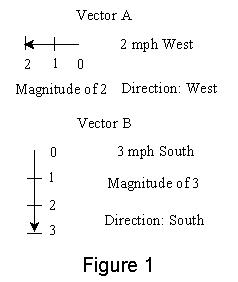
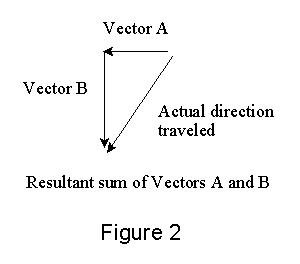
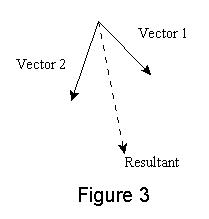 The combined direction of vectors A
and B is called resultant and is a composite of the independent
vectors A and B.
The combined direction of vectors A
and B is called resultant and is a composite of the independent
vectors A and B. 